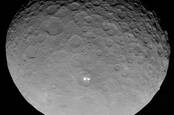New orbit will skim just 30 miles above Death Star lookalike
The Dawn spacecraft orbiting dwarf planet Ceres will soon make its final course change as NASA boffins set it up for a closest-ever flyby yet to get a warts-and-all look.
Ceres is the largest body in the Asteroid Belt and orbits between Mars and Jupiter. Dawn's been there since 2015, mapping the surface from hundreds of miles up. Its closest approach to the surface came this year, and the probe is now orbiting 270 miles (440 kilometres) above the surface.
NASA now wants to drop that altitude to less than 30 miles (50 kilometers) above Ceres' surface. The probe will send back high-resolution images and collect gamma ray and neutron spectra data from close to the surface.
"The team is eagerly awaiting the detailed composition and high-resolution imaging from the new, up-close examination," said Dawn's Principal Investigator Carol Raymond of NASA's Jet Propulsion Laboratory, Pasadena, California.
"These new high-resolution data allow us to test theories formulated from the previous data sets and discover new features of this fascinating dwarf planet."
Ceres, which was originally classified as a planet after its discovery in 1801 but then relegated 40 years later, has already thrown up plenty of surprises. Mysterious bright spots on the surface that made it look like the Death Star were spotted as Dawn approached the body, but these turned out to be pools of salty ice.
NASA has since discovered a 13,000 foot-high ice volcano on the surface, along with a seasonal water cycle and the news that the planetoid is one of only two places in the Solar System where hydrated carbonate rocks are found.
Now comes the tricky part for NASA. Dawn is powered by three extremely low-output ion thrusters and it's going to take time to get closer to Dawn's surface. Engineers simulated over 45,000 orbital manoeuvres before finding the one that keeps the spacecraft safe but also on course for more interesting science.
NASA's plan is to bring Dawn in as close as it dares, while leaving enough in the tank to reach a higher orbit so that the probe doesn't crash into Ceres and potentially infect the asteroid with terrestrial trash. ®
Sponsored: Minds Mastering Machines - Call for papers now open
Bagikan Berita Ini















0 Response to "Dawn spacecraft to get up-close and personal with dwarf planet Ceres"
Post a Comment